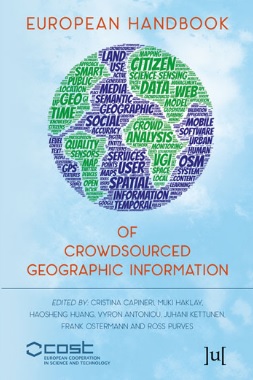Recently, a new open access handbook edited by Capineri, et.al and supported by the European Commission – COST Action IC1203 (ENERGIC) has been published.
This book focuses on the study of the remarkable new source of geographic information that has become available in the form of user-generated content accessible over the Internet through mobile and Web applications. The exploitation, integration and application of these sources, termed volunteered geographic information (VGI) or crowdsourced geographic information (CGI), offer scientists an unprecedented opportunity to conduct research on a variety of topics at multiple scales and for diversified objectives.
The Handbook is organized in five parts, addressing the fundamental questions: What motivates citizens to provide such information in the public domain, and what factors govern/predict its validity?What methods might be used to validate such information? Can VGI be framed within the larger domain of sensor networks, in which inert and static sensors are replaced or combined by intelligent and mobile humans equipped with sensing devices? What limitations are imposed on VGI by differential access to broadband Internet, mobile phones, and other communication technologies, and by concerns over privacy? How do VGI and crowdsourcing enable innovation applications to benefit human society?
GIScience Heidelberg has made several contributions to this book in different topics including:
Ch.6: Data quality in crowdsourcing for biodiversity research: issues and examples
Ch.18: Research on social media feeds – A GIScience perspective
Ch.31: Modelling the world in 3D from VGI/ Crowdsourced data
If you are interested in Crowdsourced Geographic Information you can download the book cahpters as OpenAccess from here. Enjoy!

Capineri, C et al. 2016. European Handbook of Crowdsourced Geographic Information. London: Ubiquity Press. DOI: http://dx.doi.org/10.5334/bax


